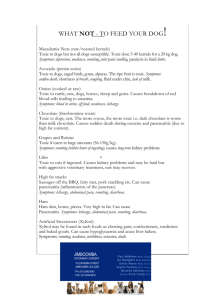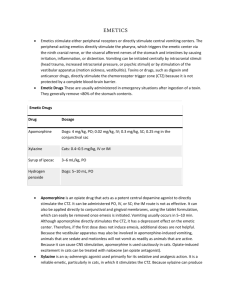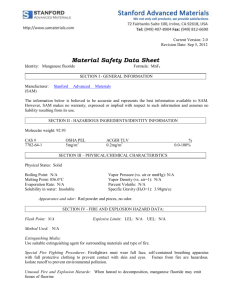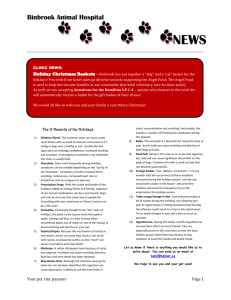Diagnosing Acute and Chronic Vomiting in Dogs and Cats
advertisement
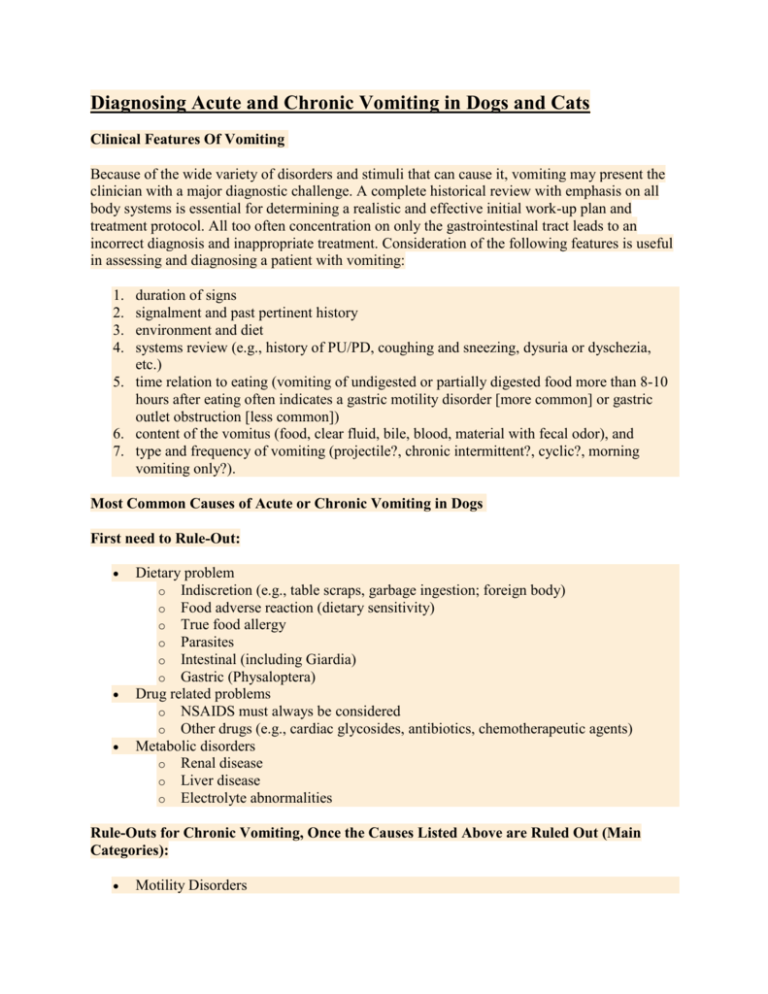
Diagnosing Acute and Chronic Vomiting in Dogs and Cats Clinical Features Of Vomiting Because of the wide variety of disorders and stimuli that can cause it, vomiting may present the clinician with a major diagnostic challenge. A complete historical review with emphasis on all body systems is essential for determining a realistic and effective initial work-up plan and treatment protocol. All too often concentration on only the gastrointestinal tract leads to an incorrect diagnosis and inappropriate treatment. Consideration of the following features is useful in assessing and diagnosing a patient with vomiting: 1. 2. 3. 4. duration of signs signalment and past pertinent history environment and diet systems review (e.g., history of PU/PD, coughing and sneezing, dysuria or dyschezia, etc.) 5. time relation to eating (vomiting of undigested or partially digested food more than 8-10 hours after eating often indicates a gastric motility disorder [more common] or gastric outlet obstruction [less common]) 6. content of the vomitus (food, clear fluid, bile, blood, material with fecal odor), and 7. type and frequency of vomiting (projectile?, chronic intermittent?, cyclic?, morning vomiting only?). Most Common Causes of Acute or Chronic Vomiting in Dogs First need to Rule-Out: Dietary problem o Indiscretion (e.g., table scraps, garbage ingestion; foreign body) o Food adverse reaction (dietary sensitivity) o True food allergy o Parasites o Intestinal (including Giardia) o Gastric (Physaloptera) Drug related problems o NSAIDS must always be considered o Other drugs (e.g., cardiac glycosides, antibiotics, chemotherapeutic agents) Metabolic disorders o Renal disease o Liver disease o Electrolyte abnormalities Rule-Outs for Chronic Vomiting, Once the Causes Listed Above are Ruled Out (Main Categories): Motility Disorders o Gastric hypomotility Inflammatory Disorders o Chronic gastritis (with or without Helicobacter) o Inflammatory bowel disease Obstructive Disorders o Foreign body o Hypertrophic gastropathy (uncommon) Neoplasia Most Common Causes of Chronic Vomiting in Cats Dietary problem o Food adverse reaction (dietary sensitivity) IBD Hyperthyroidism Liver disease Renal disease GI lymphoma (intestinal is more common) Chronic pancreatitis Heartworm disease Intermittent Chronic Vomiting Chronic intermittent vomiting is a common presenting complaint in veterinary medicine. Often there is no specific time relation to eating, the content of the vomitus varies, and the occurrence of vomiting may be very cyclic in nature. Depending on the disorder, other signs such as diarrhea, lethargy, inappetence, and salivation (nausea) may occur as well. When presented with this pattern of clinical signs, the clinician should strongly consider chronic gastritis, inflammatory bowel disease, irritable bowel syndrome, and gastric motility disorders as leading differential diagnoses. A detailed work-up including gastric and intestinal biopsies is often required for definitive diagnosis in these cases. It is important to note that chronic intermittent vomiting is a common clinical sign of inflammatory bowel disease in both dogs and cats. Vomiting from systemic or metabolic causes may be an acute or chronic sign and generally there is no direct correlation with eating and no predictable vomitus content. Diagnostic Plan If reasonable concern is established based on the history (e.g., patient is inappetent, ingested a toxin, is vomiting frequently) or physical assessment (e.g., patient is listless, dehydrated, in pain), then a minimum data base of CBC, complete biochemical profile (or specific tests for evaluation of liver, kidney, pancreas, electrolytes), complete urinalysis (pre-treatment urine specific gravity extremely important for diagnosis of renal failure), and fecal examination is essential. T4 and both a heartworm antibody test and heartworm antigen test are considered routine baseline tests for vomiting cats (approximately 40% of vomiting cats will have vomiting as a clinical manifestation of the disease). Survey abdominal radiographs are indicated if thorough abdominal palpation is not possible or suggests an abnormality (e.g. foreign body, pancreatitis, pyometra). Unfortunately these tests are often not done early enough. Even if baseline results are unremarkable they are more than justified because they help to rule out serious problems at the outset (e.g., vomiting due to renal failure, diabetes mellitus, liver disease). Alternatively, any abnormalities provide direction for initial treatment and further diagnostics. The decision for performing more in-depth diagnostic tests is based on ongoing clinical signs, response to therapy, and initial test results. These tests include ACTH stimulation to confirm hypoadrenocorticism in a patient with an abnormal Na:K ratio or to investigate for this disorder if electrolytes are normal, complete barium series or BIPS study (for gastric or intestinal foreign body, gastric hypomotility, gastric outflow obstruction, partial or complete intestinal obstruction), cPLI* or fPLI*(canine and feline lipase immunoreactivity, respectively, for diagnosis of pancreatitis in dogs and cats), and serum bile acids assay (to assess for significant hepatic disease). Barium swallow with fluoroscopy is often necessary for diagnosis of hiatal hernia disorders and gastroesophageal reflux disease. Serum gastrin levels are run if a gastrinoma (Zollinger-Ellison Syndrome) is suspected. Pancreatitis: Pancreatitis continues to be a challenging disorder to accurately diagnose, short of thorough direct examination and biopsy. Assays for amylase and lipase are of very limited value, especially in cats. In general, the following can be stated regarding the various diagnostic tests for pancreatitis: Value of the Various Diagnostic Tests for Pancreatitis Amylase/Lipase o of value as a screening test in dogs only o need to be 3x or > above normal reference range in order to suggest pancreatitis o normal does not rule-out pancreatitis Abdominal Ultrasound o highly specific, but not very sensitive, especially in cats Serum PLI o highly sensitive for pancreatitis Pancreatic Lipase Immunoreactivity (cPLI and fPLI) o Exocrine Pancreatic Insufficiency (EPI) cPLI is reliably significantly decreased cPLI is specific for EPI o Chronic Renal Failure Increased, but usually still within reference range o Dogs with Biopsy Proven Pancreatitis cPLI sensitivity is > 80% currently recommended cutoff value for dogs is >200 ug/L preliminary results are also promising for cats BIPS are barium impregnated polyethylene spheres. Traditionally, veterinarians have relied on barium liquid as the contrast agent of choice for gastrointestinal studies. However, recognized limitations of barium liquid have led to the development of barium-impregnated solid radiopaque markers for the diagnosis of motility disorders and bowel obstructions. Barium liquid contrast studies are of limited value in detecting hypomotility. Radiopaque markers can be used to investigate a number of common gastroenteric problems. These spheres have been specifically validated for use in dogs and cats and are the only radiopaque markers with which there is extensive clinical experience in veterinary medicine. BIPS are manufactured in New Zealand and are now available in many countries. Information on availability of this product, including instructions on use and interpretation of radiographic studies, can be found at (www.medid.com; 800-262-2399). One of the most reliable and cost efficient diagnostic tools currently available for evaluation of vomiting is flexible GI endoscopy. Endoscopy allows for direct gastric and duodenal examination, mucosal biopsy from these areas, and in many cases gastric foreign body retrieval. Endoscopy is considerably more reliable than barium series for diagnosis of gastric erosions, chronic gastritis, gastric neoplasia, and inflammatory bowel disease (a common cause of chronic intermittent vomiting in dogs and cats). It is stressed that biopsy samples should always be obtained from stomach and whenever possible small intestine regardless of gross mucosal appearance. Normal gastric biopsies may support gastric motility abnormalities, psychogenic vomiting, irritable bowel syndrome, or may be noncontributory (i.e., look elsewhere for diagnosis). Many dogs with vomiting due to inflammatory bowel disease have no abnormalities on gastric examination or biopsy. If only gastric biopsies are obtained, the diagnosis may be missed. Ultrasonography can be useful in the diagnostic work-up of a number of disorders that can cause vomiting. Among the problems that may be detected with ultrasonography are certain disorders of the liver (e.g., inflammatory disease, abscessation, cirrhosis, neoplasia, vascular problems), gall bladder (cholecystitis, choleliths, gallbladder mucocele), GI foreign bodies, intestinal and gastric wall thickening, intestinal masses, intussusception, kidney disorders, and others. Needle aspirations and/or biopsies can be done at many sites under ultrasound guidance. Abdominal exploratory is indicated for a variety of problems including foreign body removal, intussusception, gastric mucosal hypertrophy syndromes, procurement of biopsies, and for resection of neoplasia. Diagnosis of Vomiting Stage 1-Baseline Assessment History and physical examination Conservative vs. more aggressive diagnostic plan based on patient's condition and clinician's concern Conservative Approach Serious or Systemic Clinical Signs Fecal examinationa Selected diagnostics Specific/symptomatic therapy Fecal examinationa Parvovirus test if indicated Survey radiographs Appropriate specific/supportive therapy Complete blood count Complete biochemical profile Urinalysis T4 (cats) Heartworm antibody test (cats) Stage 2-Further assessment (if vomiting persists or initial tests indicate further investigation should be performed promptly): Special Blood Tests o Corticotropin stimulation o cPLI or fPLI (pancreatitis) o Leptospirosis serology o Bile acids assay (to asses liver function) o Coagulation tests (consider in patients with hematemesis/melena) Contrast Radiography o Barium contrast o Air contrast gastrogram (to further assess for gastric foreign body) o BIPS (barium-impregnated polyethylene spheres; with food to assess GI motility) Ultrasonography o Evidence of GI or non-GI disease o Aspirates or biopsy o Abdominocentesis Nuclear Scintigraphy o Transcolonic portal angiography for detection of portosystemic anomaly o GI motility study Stage 3-Invasive Procedures Flexible GI endoscopyb (minimally invasive) o Examination, biopsy, foreign body retrieval Laparoscopy o Biopsies (e.g., liver, pancreas) o Aspirates (e.g., gall bladder, lymph nodes, mass lesion) o Intestinal biopsy Surgical intervention o Therapeutic or exploratory with multiple biopsies *GI parasites, including Giardia, should always be considered in dogs with acute or intermittent vomiting. Best baseline testing on a single fecal sample includes centrifugal flotation and Giardia antigen test. b Endoscopy is a diagnostic or therapeutic tool that can be used in Stage 1, Stage 2, or Stage 3, depending on the clinical situation. References 1. DeNovo RC: Diseases of the stomach. In Tams TR, ed: Handbook of small animal gastroenterology, ed 2, Philadelphia, 2003, WB Saunders. 2. Richards JR, Dillon R, Nelson T, Snyder, P: Heartworm-associated respiratory disease in cats - a roundtable discussion. Veterinary Medicine June 2007. 3. Tams TR: Gastrointestinal symptoms. In Tams TR, ed: Handbook of small animal gastroenterology, ed 2, Philadelphia, 2003, WB Saunders. 4. Tams TR: Chronic diseases of the small intestine. In Tams TR, ed: Handbook of small animal gastroenterology, ed 2, Philadelphia, 2003, WB Saunders. Source: http://www.dcavm.org/07sep.html

